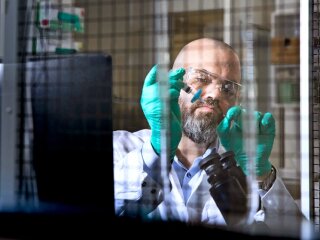Pain is commonly divided into acute or short-term pain and chronic or long-lasting pain. Orion is focusing particularly on the latter.
“Our vision is to give chronic pain patients their lives back,” says Pain Research Director Carina Stenfors.
Chronic pain is a global problem: one in five suffers from chronic pain at some point in their lives, says Stenfors. For pain to be chronic, it has lasted 3‒6 months or longer.
“The most common chronic pain is low back pain, frequent in the working-age population. Pain comes with a price tag: in addition to human suffering, chronic pain can have economic and social consequences through sick leave and incapacity for work.”
One of Orion’s R&D core therapy areas is pain research. According to Carina, several drug candidates are currently in the preclinical phase, which means that they have not been tested in man yet. Orion has initiated a Phase I clinical trial with ODM-111, a NaV 1.8 channel blocker for the treatment of acute and chronic pain.
One product has already been tested in man - it is not a drug, but a pain therapy based on virtual technology 1 , unique in its kind.
All treatments can have adverse effects
Pain is today usually treated with anti-inflammatory drugs such as ibuprofen or antidepressants, antiepileptics or opioids, the opioid mainly for acute pain. According to Stenfors, treatment is effective if pain symptoms decrease by at least 50 percent.
“But for the majority of people the relief is lower than that and comes with adverse effects.”
Younger patients may have to use pain relief for a long time.
“Pain medications are difficult and complex to develop. Testing can also be challenging, as drugs must be absolutely safe and effective.”
Pain and depression – crucial relationship between cause and effect
Pain management has stimulated a lot of interest in Finland as well: some time ago the University of Helsinki arranged a public seminar with lectures by pain experts, professors Eija Kalso and Nuutti Vartiainen. According to Eija Kalso, Director of the Pain Clinic at HUCH, poor sleep and anxiety can easily lead to a vicious circle where it is difficult to know the difference between cause and effect.
Stenfors says that chronic pain can also increase suicide risk.
“Which comes first: a depressed person suffers from poor sleep and experiences pain, or a person in pain cannot sleep and gets depressed? It’s a vicious cycle that needs treatment.”
Brain imaging can also be used to examine chronic pain patients and to understand cause and effect. According to Neurosurgery Resident Nuutti Vartiainen, measuring spontaneous brain activity may in future help diagnose chronic pain and develop treatment methods.
Rating patients by pain, not disease
In principle, the development from acute to chronic is very similar in depression and pain. Stenfors says that pain is often a symptom caused by different diseases, such as cancer, diabetes or AIDS One tries to treat the underlying disease first and hope that this would ease the pain as well.
“But instead we could use the pain itself as an indicator and try to find the factors and mechanisms causing it. This could lead to development of various pain treatments.”
Orion has collaborated with a number of gene banks in Finland and abroad. The symptoms of pain are often directly associated with genes.
“We are expecting more research data about pain mechanisms in the near future to be able to group patients by their symptoms. These are fascinating times: when it comes to pain, we should make use of novel research and be open to new ideas for treating pain patients.”











